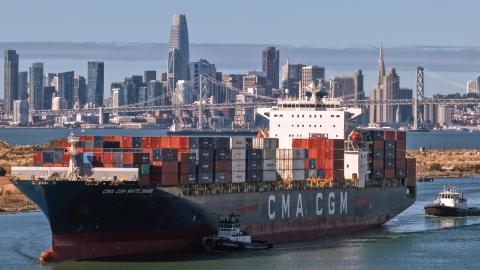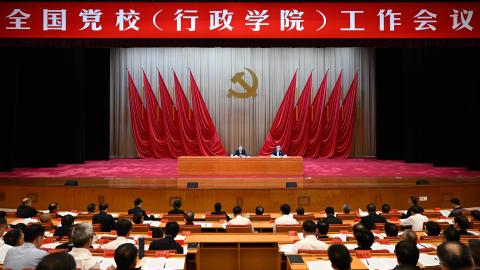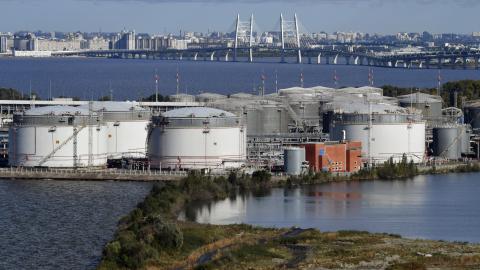Now that I have indicated via the heading of these remarks that my subject is “China’s Grand Strategies” I will begin by saying that I will try to avoid using the term “China” as much as I can. To be sure the word “China” will pop up from time to time; how could it be otherwise in a talk that is, after all about, well, China? But I will try to avoid the word nonetheless because it is, for my purposes here, too abstract and too impersonal. “China” as such does not have interests, nor does “China” as such pursue grand strategies. Instead, I will try to focus on the actual people who have run the place commonly called “China” at different times, to look at things from their point of view, to reflect on how they analyzed and responded to challenges they believed they faced.
In my opinion, there are real advantages in approaching things this way. In the first place, the place commonly called “China” has existed in different sizes and different shapes through history; it has been fought over and controlled and ruled and governed by self-conscious men who thought of themselves as innovators as much as they thought of themselves as inheritors and conservators. Thus in talking about Grand Strategies, I will use the name of different regimes—different ruling arrangements if you will. Three of the arrangements I will discuss are defunct imperial dynasties—the Yuan (1271-1368) the Ming (1368-1644) and the Qing (1644-1912.) Two of them are still-existing Republics—the Republic of China (1912--) and the People’s Republic of China (1949--.) As I will describe, there are important differences among them but there is one overriding commonality: Each had to a design a strategy to gain power and then, having gained power, each had to design a strategy to hold onto it. The argument I wish to make, and the principal point I wish to leave with you, is that Grand Strategy for such people is not some kind of pre-existing platonic ideal that lives on through the ages. Rather it is better understood as part and parcel of the ruling regime’s efforts to maintain itself.
While I will have more to say about today’s ruling arrangement called the People’s Republic of China (PRC) I hope you will allow me a digression at this point to say that the men in Beijing who run the PRC unceasingly encourage us to believe that it is the name of a place but, in fact, it is the name of a system, a modus operandi, an organization. It is an arrangement whereby an organization called the Chinese Communist Party (CCP) endeavors to maintain the power it acquired in 1949 after its victory in a long civil war. Just as a man named Zhu Yuanzhang set up the Ming dynasty in 1368 and his successors changed things over time so that the dynasty lasted until 1644, a man named Mao Zedong set up the set up PRC in l949. His successors have sometimes tinkered with it and have sometimes made profound changes in it, but the PRC will probably not last 276 years.
If you will permit me a further digression, the CCP, unlike past emperors, always explains itself. It has described at length how both its tinkering and its transformations have been the result of the Party’s assessment of the circumstances with which it had to deal. The mission of the CCP is perennially daunting; these days it is an organization of about eighty million members which works every day to maintain a monopoly on political power in a place with about one billion three hundred and fifty million inhabitants. The PRC has what it calls a constitution. This document describes the purposes for which PRC was established. Article one reads:
__The People's Republic of China is a socialist state under the people's democratic dictatorship led by the working class and based on the alliance of workers and peasants.__
__The socialist system is the basic system of the People's Republic of China. Disruption of the socialist system by any organization or individual is prohibited.__
The Chinese Communist Party also has a Constitution. You can read an English-language translation of it on the web. Do not be put off by the seeming mumbo-jumbo of this very long document. Over the years, the Party has developed a way of representing itself to us in our own language that is always stilted and frequently seems comical. Nonetheless, this is the Party’s way of explaining things and it is not presented to us for our amusement. Rather, the catchphrases and peculiar locutions have real meaning, albeit the Party’s meaning, not ours. The Party’s presentation of itself is in fact quite straightforward—once you grasp the unique way in which it uses words with which you think you are familiar. It is reminiscent of one of Alice’s conversations in Wonderland: “When I use a word,” Humpty Dumpty said, in a rather scornful tone, “it means just what I choose it to mean, neither more nor less.”
As prospective United States naval officers, there’s a final point you should grasp and reflect on. The CCP, via the PRC, has also created a navy, though it is part of what the CCP calls the People’s Liberation Army (PLA.) The PLA was founded in l927 as the Party’s military arm and it still is. Liang Guanglie, the PRC’s Defense Minister who hosted Secretary Panetta in Beijing in September is, as you might put it, dual-hatted. Yes, he’s the Defense Minister, but he knows who his boss is. Speaking this past August l on the country’s annual Army Day celebration, he said:
"We always give top priority to enhancing political awareness and unswervingly follow the basic principles and system of the Party's leadership." They know what this means, even if the meaning is too often lost on us.
***********
As the Party says today, and as the Emperors before them understood, the trick in all of this is to understand any regime’s ambient circumstances and then figure out how to cope with them. As the renowned ancient classic called the Book of Changes reminds us, things change; the superior statesman steers his way through the changes but the lesser man succumbs to them. Some men are better at this than others. Many have attempted what the Chinese call The Great Enterprise, that is, seizing control of the country, but only very few have succeeded. Accordingly, and as I promised at the outset, I will say something about how three dynasties and two republics thought about the changes they confronted and what they tried to do about them. I will then speculate about how today’s CCP sees things today and how both continental and maritime visions of Grand Strategy fit into its analysis.
On many occasions during its history, “China” was actually part of somebody else’s empire. The Yuan period (1271-1368) was one such time when “China” was part of the vast Mongol Empire. The Emperor of China that Marco Polo met in 1275 was Kublai Khan, a grandson of Genghis Kahn. The Khan family—if we may use the term—had already assembled the largest parcel of real estate in the history of the world even before it undertook to acquire China. Indeed, as the ever-amazing Wikipedia tells us:
The Mongol Empire existed during the 13th and 14th centuries A.D., and was the largest contiguous land empire in human history...It eventually stretched from Eastern Europe to the Sea of Japan, covering large parts of Siberia in the north and extending southward into Southeast Asia, the Indian subcontinent, the Iranian plateau, and the Middle East. At its greatest extent it spanned 9,700 km (6,000 mi), covered an area of 24,000,000 km2 (9,300,000 sq mi.)
By way of contrast, the United States and Canada, combined, cover about 7.5 million square miles.
To establish their rule in China, the Mongols needed, in the end, to dispose of the remnants of the Song Dynasty, a home-grown imperial regime that had held power since 960, or for about three centuries, and for the purposes of our discussion here, how they did it is less important than that they did do it. Indeed, the Yuan Dynasty extended its rule into Southeast Asia and it attempted a conquest of Japan by sea.
The Song era, even though it ended ingloriously, is remembered as one of the greatest in Chinese history. It interests us here in this room today because it had been successful in coping for a long time with a series of strategic threats, almost all of which originated in Inner Asia. Fending off Inner Asian peopled had been a challenge for Chinese dynasties for centuries, and they had had better or lesser success at it, which is why “China” has spent almost half of its history under the control of non-Chinese polities of one sort or another. The Song themselves were military innovators both in tactics and weaponry and were the first to bring maritime power to bear against their rivals on land in a major way.
But the self-evident lesson was that a dynasty of Chinese, no matter how rich, cultured, sophisticated or inventive, would sooner or later succumb if it could not, through an effective mix of diplomacy and force, cope with threats that originated from deep within Eurasia.
Of course, by definition, the Yuan dynasty of the Mongols did not have to worry about incursions from Mongols. The problem was now one of what we would call internal security. The Yuan was thus not replaced by some other Inner Asian conquerors but, rather, by the Ming Dynasty, the creation of Chinese people, the Khans’ former subjects. Indeed, one could say that the establishment of the Ming dynasty was the result of an anti-colonial national independence movement whereby China successfully seceded from the Mongol Empire.
So in this pattern of dynastic oscillation between rule by “foreigners” and rule by homebodies, the principal strategic challenge of the Chinese Ming was to learn from the demise of the Chinese Song. Over time, Ming strategy became one of sustained efforts to seal off China from Central Asia and to disrupt China’s contact and commerce with the region, rather than to resort to co-optation and conquest. Let us call this strategy Great Wall-ism, because it is in Ming times that the Great Wall, as it is commonly thought of today, was actually built. Arthur Waldron, the definitive historian of the Great Wall, has described how the wall became the physical embodiment of the Ming dynasty’s outlook. In the Ming mind, there was a fundamental, unbridgeable, and irreconcilable discontinuity between “China” and people and things which were “Chinese” on the one hand , and “not-China” and people and things which were “not-Chinese” on the other.
However, this should not lead us to think that the Ming were “isolationist” in a broad way. Even as the dynasty took pains to quarantine Inner Asia, it also dramatically expanded China’s contact and commerce with Maritime Asia and, today in fact, the Ming era is best remembered for that. We learn from this subject’s major historians, Geoffrey Wade and Edward Dryer, how China became the world’s leader in nautical technology and how its fleets carried an enormous seaborne trade. The PRC, in searching for historical precedents for its own turn toward the sea in the past thirty years, has focused much attention on the now-famous seven voyages of Zheng He in the early 1400s. Beyond Zheng’s iconic expeditions, Ming sea power was an important presence in Southeast Asia, South Asia, Arabia, and East Africa.
In that Ming vessels were far in advance of anything Europeans floated at the time, it is delightful to speculate on the effects of a rounding of the Cape of Good Hope by Admiral Zheng and his continuing to sail northward to Europe—Vasco da Gama in reverse so to say. Yes, the Ming had a grand maritime vision, but not grand enough to transform the history of the world in this way. Though no one understood it at the time, the rise of European sea power would create empires of a new, seaborne, type that would, over time, supersede the great continental empires.
Meanwhile, and interestingly enough, though the Ming would succumb in the 1640s to yet another group of Inner Asian empire builders, the Manchus, the Ming’s demise had been hastened by a seaborne challenge that arose fifty years before, in the 1590s. For some reason, the then-military dictator of Japan got into his head that he ought to invade and conquer the Ming Empire and he set out do so via the Korean peninsula. (Sound familiar?) Japanese and Ming armies fought in northern Korea. Japanese ambitions were thwarted but the Ming regime was further debilitated. A man named Nurhaci (1559-1626), who was busy creating the Manchu military machine which would breach the Great Wall and move into China Proper in the 1640s, was paying close attention to these nearby events and he personally observed some of the combat. In 1618, Nurhaci announced his intention to oust the Ming; his descendants installed themselves in Beijing in 1644, and then spent the rest of the seventeenth century consolidating their rule throughout the country.
The new Qing dynasty departed from its Ming predecessors in both domestic and foreign policy, the result of its own analysis of the causes of the Ming demise. Any libertarians among you will be pleased to learn that, in the main, the Qing emperors embraced China’s “small state” tradition. Our country’s two leading scholars of the formative years of the Qing, William Rowe and Pamela Kyle Crossley, have educated us about (among other things) the Qing embrace of decentralization and of China’s “small state” tradition. In the main, the Qing emperors thought the Ming emperors had departed too far from it, that the country had become over-governed, overtaxed, and overregulated, that a freer market and more vibrant civil society would free the government from unnecessary tasks and expenses so that it could focus on the main purpose of the state—warfare.
The Qing approach to national security was also different, especially in its strategy toward Inner Asia. After all, the Manchus were themselves an Inner Asian people who had carefully studied the failures of the Song and the Ming to cope with Inner Asia. The Manchus were not Chinese, and so had an entirely different ideological perspective toward the continent. Their plan was not to separate “China” from “not-China” but rather to combine the two into a single polity. Like the Mongols, they set about to create a multi-lingual, multi-cultural empire, of which China Proper was certainly the most important part, but not the only part. The historian Peter Perdue has written the seminal work about the extraordinary Manchu military campaigns which achieved this vision. By the time they were done, the Manchus had created a “China” twice the size of the one they had initially taken over. To China’s historic core, they added Mongolia, Xinjiang, Tibet, Taiwan, and parts of Siberia.
Here, now, a point that is critical to understanding the today’s situation, of the place commonly called “China:” The Manchus developed an approach to governing their vast domain that differed from a traditional “Chinese” one. In particular, the Emperor himself, though he may have displayed a sinified face to his Han Chinese subjects, did not pretend either to himself or to his many other, non-Chinese subjects that he was Chinese. The enlargement of the empire was therefore not understood at all as the enlargement of “China,” but, rather, as the accretion of ever more and diverse holdings within a Manchu imperial portfolio. Thus, the emperors did not, on principle, pursue the sinification of newly acquired possessions, but instead respected their traditions and often represented themselves as somehow belonging to one or another of those diverse traditions rather than to the Chinese one. Indeed, the various parts of the Manchu empire developed a loyalty to the emperors seated in Beijing precisely because they viewed them not as the embodiment of an expansion of Chinese influence, but as something quite the reverse: for these outliers, the Manchu emperors were a bulwark against Han Chinese domination, not the agent of it.
The Manchu project was complex and expensive but it seemed to have solved fundamental strategic problems insofar as the protection of “China” was concerned. Of course, what it did not contemplate was the arrival of an unprecedented seaborne threat, first in the form of the West’s navies, and then in the form of the West’s ideas about philosophy and politics. This was a strategic challenge without precedent, a unique, dynasty-threatening situation which occupied the Manchu court from the 1830s until the dynasty’s end in l912.
The Manchus soon came to face a war on three fronts. Imperial Russia pressed in from Inner Asia, the West (and, later, Japan) pressed in from the sea and, to these foreign threats, the peoples of the Empire added a domestic security challenge of their own—a series of rebellions against Manchu rule. Han Chinese created the most famous, the Taiping Rebellion, which lasted fifteen years (1850-1865), extended over much of south and central China, featured huge battles with armies numbering in the hundreds of thousands, and enormous collateral devastation, all resulting in about twenty-million deaths overall. Stephen Platt’s recent book about these events is a fine account and it is notable for placing this great civil war in a larger international context, thus helping us make better sense of how such internal events enter into calculations about the international balance of power.
But there were also other large uprisings, most notably the Yakeb Beg rebellion of the 1870s among the Manchus’ Turkic Muslim subjects in the northwest and the Panthay Rebellion (1855-1870) organized by Han Chinese Muslims, and other Muslim and non-Han peoples, in the southwest. These, too, had international ramifications as the dynastic politics of the Manchus became connected to those of other empires. These major rebellions and their diplomatic implications are an underappreciated aspect of the many challenges of late Qing-era Grand Strategy. Put yourself in the position of what we would call a national security policy planner at the Qing court. There was not only the intellectual challenge of getting the analysis right; there was then the minefield of intrigue that had to be negotiated before any policy could be implemented.
Yet, even as, at one at the same time, the Qing had to cope with existential continental, maritime, and internal threats, the court was also initiating far-reaching “self-strengthening” reforms, Students of this era, by the way, have come to see these late Qing innovations designed to connect the Manchus’ realm to the great wave of technology-driven globalization of the late nineteenth-early and twentieth centuries as the real precursors of Deng’s Xiaoping’s reforms of the late l970s. There were also some steps taken toward what we would call a constitutional monarchy. These were mighty efforts but they failed. As those of you who have seen Bernardo Bertolucci’s masterpiece, The Last Emperor, will vividly recall, the dynasty came to quiet end in 1912 with the abdication of a five-year old boy emperor.
I describe this because it illustrates how the program of the Qing in its last decades laid down the program of its successors. The late imperial agenda became the post-imperial agenda. The Qing abdicated in favor of something called the Republic of China, but RoC was just a concept. It had neither form nor content. The new Republic’s first decision was fateful; it defined its boundaries as those of the Qing Empire. It understood the strategic necessity of holding on to Tibet and Xinjiang and other outlying areas if the Han Chinese core off the Republic was to survive. It then made another fateful decision; it decided to abandon the Manchus’ multi-cultural approach to governing these vast territories and resolved, instead, to govern them as if they were Chinese and the people who lived there were Chinese.
This decision by the new republic set in motion a fundamental change in Chinese attitudes to the outer reaches of the old empire. Prasenjit Duara describes it this way: “Older conceptions of unwelcoming frontier regions whether in the Northeast, West, or Southwest, and covering over half the Qing Empire, were transformed and the regions produced anew as vital national territories. Anthropology, history, and geography, as academic disciplines and as popular discourse, became engaged in the production of these places as part of the national narrative.” The RoC government of the Kuomintang in the l920s, l930s, and l940s, worked out elaborate theories and policies for the realization of this new “China.”
In other words, and in a complicated way, China’s twentieth century nationalism set in motion a new distinctly Chinese imperialism, fundamentally different from the imperialism of the Manchus which preceded it. It also became part and parcel of both foreign policy and Grand Strategy, as the RoC’s war with Japan in the l930s and l940s showed, and which I will describe in a moment. Right now, it’s important to remember that the Qing policy of “self-strengthening,” that is, of state building, was also adopted by the RoC. In all this, RoC was flexible in its diplomacy, as it built up relations in the 1920s with the new Soviet Union and, after 1933, with the third Reich of Adolf Hitler, and, all along, with the United States, RoC’s de facto ally against the seaborne threat posed by Imperial Japan.
The RoC, already in a difficult situation, was challenged further by the outbreak of open, full-scale, hostilities with Japan in 1937. Japan came to occupy all of the country’s coastal ports and began to menace Southeast Asia and even India in an effort to complete China’s isolation. Once again, Inner Asia entered into a regime’s calculations about its own survival. The RoC had moved its capital to Chongqing, about 2,000 miles up the Yangtze, and now looked inward to Central Asia, to India via Tibet and to Burma for keeping open critical supply lines. Professor Yu’s book, The Dragon’s War, describes some of this.
In time, an allied theater of operations, the China-Burma-India Theater, was created to support the RoC. Discussions of the strategic significance of CBI Theater have been overshadowed by the story of the epic feud between RoC President Chiang Kai-shek and U.S. Army General Joseph Stilwell and the lessons the rest of us are supposed to draw from that. But, as we will see in a moment, its strategic legacy was the continuing struggle for control of the “backdoors” into China. That struggle was, and remains, at the heart of the Grand Strategy of the next victor in the Great Enterprise, the Chinese Communist Party.
In fact, the new PRC founded in 1949 learned a lot from all of this. Its first order of business, even before the launching of its radical domestic agenda, was the re-conquest of those old Qing domains, Xinjiang and Tibet. These had become de facto independent during the course of the Second World as the RoC could not enforce its writ but the new PRC acted with a sense of urgency. It sent military forces into Xinjiang in late 1949 and also into Tibet in early 1950. The PRC also began almost immediately to secure its position on the continent. It first made an alliance with the USSR, having first pre-empted any Soviet moves into Xinjiang in the wake of the RoC’s defeat. It then attempted, through its support of so-called wars of national liberation in Malaya, Vietnam, Laos, Cambodia, Thailand, and Burma to secure its southwestern “backdoors.” In the 1960s, Mao Zedong, no doubt recalling the RoC’s experience, wanted to turn Sichuan into an impregnable inland redoubt. PRC further shored up its position in adjacent Tibet through its brief border war with India in l962, which tilted the military balance at the “top of the world” in the PRC’s favor.
Interestingly enough, the PRC also acted on its maritime frontier, but not by naval means. It supported the Huk insurgency in the Philippines, hoping a Huk victory would produce a pro-PRC government that would end ties with the United States. It was involved in a plot to overthrow the government of Indonesia in 1965, made famous as The Year of Living Dangerously, as re-enacted by Sigourney Weaver and Mel Gibson.
As we know, all of this was dramatically reversed in the late l970s. The fundamental decision was to scrap Mao Zedong’s vision of a socialist autarky and, instead, to opt to emulate great trading economies like Japan, South Korea, Taiwan, Hong Kong, and Singapore. The PRC did this out of necessity because it had come to the brink of collapse. But, in opting for profound domestic restructuring, the PRC also had to abandon older foreign relations priorities. Thus, it allied with the United States and opened itself to the world. The collapse of the USSR in 1991 secured the PRC’s Central Asian flank in a way the Qing emperors could never have imagined. The Qing’s “self-strengtheners” would also be awed that high-growth economic policies had created enough wealth for a new maritime efflorescence to the point where now the PRC could contemplate challenging U.S. naval dominance in the Western Pacific. The “leapfrogging” into the Third World of Mao’s time now takes the form of substantial investments in Africa and Latin America.
The PRC has perfected a sometimes flamboyant way of describing its purposes and, therefore, we tend not to focus on them. What should interest us, however, is that though PRC tactics and rhetoric may change over time, bedrock strategic objectives abide. The buildup of military forces in Tibet and Xinjiang has in fact been relentless for decades. The PRC no longer backs “wars of national liberation” on the Southeast Asia mainland or in Africa but instead uses a variety of new commercial and political gambits to secure its objectives in these places.
These changes in approach befit altogether a PRC which has changed dramatically from what it was between l950 and l979. The PRC of today is a society that is unrecognizable from the vantage point of thirty years ago and, therefore, the projection of itself into the world must perforce be different from it what was then. Accordingly, if we wish to speculate about how the PRC might project itself into the world in the future, we must do our best to figure out how major internal changes still underway in the country will affect its grand strategy and thus its modus operandi.
Here at Annapolis and, especially, at the Naval War College in Newport, there is great awareness of the growth in the PRC’s maritime power. As I suggested, this is a follow-on to an internal transformation which connected the lion’s share of the country’s economy to places across the sea. Less noticed, but potentially as significant, is a new phenomenon in the PRC’s internal development which is driving the PRC’s activities in the opposite direction—deeper into Euraisa. To use a term the Party employs when it talks about the aspirations of non-Han peoples for true autonomy, this is a new form of “splittism,” but one that originates within the predominantly Chinese parts of the country. It is the outgrowth of what began a decade ago as a determined effort by Beijing to promote greater national integration. Instead, it is producing something else again—a West China and an East China, split by fundamental differences over internal policy and, potentially, over future strategic policy also. In fact, there are indications that each one has begun to see itself as the core of an emerging world power in its own right, not just as a subordinate piece of a Beijing-controlled unitary strategic actor.
At the root of it all is the truly enormous regional gap in growth and income that the first two decades of Deng Xiaoping’s reforms produced. By the end of the 1990s, this vast disparity in wealth between two parts of the country—a coastal region connected to the world market by sea, and a far larger hinterland where rates of economic growth were much slower—had become the PRC’s single most important fault line.
The gap also had strategic implications because the coastal region’s dynamic economy was rapidly detaching itself from the rest of the country. The coast’s factories and seaports were developing a dependency on an outer world beyond the direct political control of Beijing. Without anyone’s much thinking about it, “maritime” and “ocean” became the words which expressed Rising China’s reliance on foreign resources and foreign markets. For Western observers in particular, the PRC’s military build-up focused on the South China Sea, and its rapid economic outreach across the oceans into Africa, Latin America and the Middle East best represented the strategic challenge of Rising China.
Beijing’s official response, launched in 1999, came to be known as the “Go West Policy.” It was a hugely ambitious scheme affecting about two-thirds of the country’s territory and involving a mobilization of monumental amounts of capital. Its focus was nearly always on expensive, and frequently daring, engineering and transportation projects, designed to provide a basic infrastructure to developing the country’s interior and western provinces. Today, some of the “Go West” program’s signature creations—the remarkable Qinghai-Tibet railroad and the monorail mass transit system in Chongqing, for example—are impressively visible. Even more impressive is the rapid development of inland manufacturing towns and ports—cities like Chongqing and Kunming, Chengdu, and Kashgar—which now stand as the staging grounds for ever more ambitious plans to expand outwards, beyond China’s southern and western borders. Thus, the PRC is making huge investments in Eurasia—especially in Islamic Eurasia, a region with more than its share of pitfalls, as Americans can attest—even as it further engages itself in places far across the sea.
Once again, then, continental and maritime strategic options present themselves to important decision-makers in Beijing, except that, this time, the analytical conflicts and political tensions are internally generated rather than the result of forces pushing in from the outside. The relatively benign security environment around today’s PRC as compared to the past no doubt makes “all-azimuths” expansion seem practical, but it is in fact not sustainable. Meanwhile, within the PRC’s increasingly dysfunctional political system the easiest course for the leadership, and the one that it is following, is to give both “continental-ists” and “maritime-ists” their head without any real effort to evaluate dangers and opportunities inherent in both courses. This is reminiscent of what happened in Japan in the l930s when a too-weak central government could not adjudicate between those who wanted to move north and those who wanted to strike south. So Japan did both—attempting vast conquests on the Asian mainland while, at the same time, starting a war with the world’s most formidable maritime power.
And beyond these two fronts—the continental and maritime—today’s PRC must also engage on a third front. The regime’s internal security budget almost certainly exceeds it military budget, and a goodly amount of that has as its real aim the intimidation of people who live inside the country, not the deterrence of anyone outside the country who may be planning to invade, because there are no such people. “China” does not need 10,000 tanks but the Chinese Communist Party, which has control of them, very much needs them to maintain its monopoly on political power.
Meanwhile, the Grand Strategy of the United States will have to perform this analysis in reverse, that is, it must decide how and to what extent to engage the PRC on all three of these fronts, to find the right balance so as to raise the costs of PRC’s ambitions until they become unbearable.











